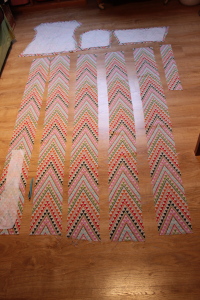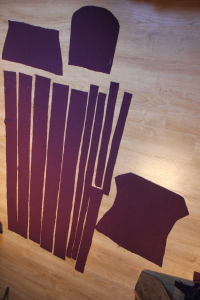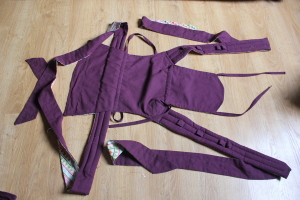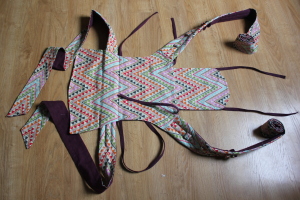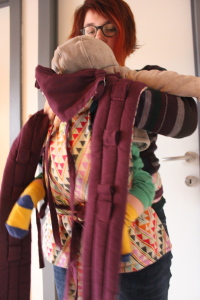Sinds november 2015 ben ik naast foodie ook mama en dus worden de culinaire activiteiten eventjes ingewisseld voor de wondere wereld der baby-spulletjes. Van mijn schoonzus kon ik een tricot-slen draagdoek lenen en na het overwinnen van enige terughoudendheid (dat gaat nooit lukken/wat een gedoe met die lange flappen/is dat niet voor hippies…) en het wat beter leren knopen (zodat het niet voelde alsof ik plotseling weer 41 weken zwanger was) zat ons kleintje daar lekker knus tegen mij (of papa) aan. En wat heerlijk om de handen af en toe vrij te hebben terwijl de baby toch getroost wordt door mama’s warmte. Om nog maar te zwijgen van het gemak op het Brusselse openbaar vervoer: gedaan met speuren naar liften of lief kijken naar anderen om de maxi cosi een trap te helpen opsjouwen… Helemaal enthousiast geworden door deze nieuwe perspectieven die zich voor ons openden en met een trip naar Parijs in het vooruitzicht (waar de metro’s naar het schijnt een hel zijn voor de doorsnee buggy) schreven we ons in voor een workshop dragen bij Myriam van Dragen in Brussel en maakten we kennis met de verschillende dragers. Naast onze rekbare draagdoek, waar ons hummeltje stilaan is uitgegroeid, zijn er namelijk ook geweven draagdoeken, ring slings, mei tais, …
Na de draagworkshop ging ik in webshops op zoek naar een model dat me aanstond, maar de prijzen van de meeste draagzakken maakten even de Dagobert Duck in mij wakker. Mooi, maar niet goedkoop. En na wat surfen en rondsnuffelen op blogs van handige mama’s begon deze doe-het-zelfster weer goesting te krijgen om acher de naaimachine te kruipen.
Dus terwijl ik een uitstap naar de stoffenwinkel plande tijdens de laatste dagen van de solden én van m’n bevallingsverlof stak de projectkoorts op. Jeweetwel, dat gevoel van uitdaging en een hoofd vol plannen en ideeën wanneer je aan iets begint dat je eigenlijk doodgraag doet – in mijn geval achter de naaimachine kruipen. Ik deed veel inspiratie op door de blogs van Grumbles And Grunts en Barefoot And Pregnant Esquire. Ik besloot een mei tai te maken naar het model van de Girasol MySol, dat ik ook had uitgetest in de draagcursus. Het voordeel van de MySol is dat er geen gespen of andere plastic/metalen onderdelen aan te pas komen, alles werkt met touwtjes en linten. Bovendien kun je hem groter en kleiner maken, zodat hij geschikt is voor hele kleine baby’s tot en met hele grote. Ik vond de afmetingen van de MySol hier.
Mijn draagzak heeft 2 meter lange schouderlinten en 3 meter lange heuplinten. Daarmee maken zowel mijn man als ik (beide doorsnee grootte) vlotjes een knoop vooraan met het heuplint en een knoop achteraan met de schouderlinten. Je kan dus iets korter gaan (zeker voor de heupen), zorg dan wel dat je eerst de nodige afstand meet op jezelf met een lintmeter en rekening houdt met de knopen die je nog moet leggen. Veiligheid is belangrijk dus maak geen te korte linten (je moet een dubbele knoop kunnen leggen) en kies zeker een stevige stof en kwaliteitsvolle draad!
Deze draagzak is helemaal uit stof gemaakt in twee kleuren, zodat je hem langs twee kanten kan gebruiken (handig voor als hij bij je hele kleerkast moet passen, of als je partner doorgaans een meer/minder flashy kleurenpalet hanteert). Je kan hem uiteraard ook uit één kleur te maken, dit bespaart je mogelijk een beetje stof. Ook dan kan je hem nog langs twee kanten gebruiken.
De benodigdheden kostten mij alles tesamen zo’n 60 euro (stof + vulling + draad), maar als je op zoek gaat naar goedkope stofjes of kan werken met resten kan het uiteraard nog een pak goedkoper. Onderaan de pagina vind je enkele tips om goed aan de slag te gaan met de drager, maar ik kan je van harte aanbevelen om een workshop dragen te volgen, dat kan bijvoorbeeld bij Myriam.
Veel succes ermee en laat mij zeker iets weten als je het zelf uitprobeert! Schattige foto’s van kleintjes in draagzakken please!
Wat heb je nodig:
Textiel: ik gebruikte stevige, canvasachtige interieurstoffen van 100% katoen (gevonden in Maison Dorée, de keten van de Nekkertex). Ik koos voor niet té dikke, ademende stoffen zodat ik in de zomer niet loop te puffen (een baby geeft al genoeg warmte af – letterlijk en figuurlijk :-)). Gordijn- of meubelstof, denim, een stevige tafeldoek, de meeste stoffen van IKEA… als het maar stevig aanvoelt (als in, je durft je meest precious bezit erin ophangen) en ademt. Ik heb geen ervaring met rekbare stoffen voor zo’n draagzak, dus ik zou het niet aanraden – alleszins op eigen risico uit te proberen.
De (gordijn)stof die ik kocht was 280 cm breed en ik kwam ruim toe met 1,5 meter van elke kleur – ik kon er zelfs twee zakken van maken. Belangrijk is wel om te weten dat ik de linten heb geknipt in de draadrichting (en dat ook zou aanraden voor de stevigheid), waarbij ik alle linten uit twee delen heb gemaakt (1,5m + 0,5m voor de schouderlinten en 1,5m + 1,5m voor de heupen). Als je stof 280 cm breed is kom je ook toe met 1 meter van elke kleur, maar dan moet je drie panelen aan mekaar zetten voor het heuplint.
Als je stof koopt van 140 cm breed (zoals de meeste stoffen) heb je 1,5 meter van beide kleuren nodig.
Als je de hele doek uit één kleur maakt volstaat 1,5 meter van 280 cm breed of 3 meter van 140 cm breed.
Let op: je hebt iets meer stof nodig als je kiest voor stof met een patroon, als je het patroon mooi wilt laten aansluiten. Hoeveel meer hangt af van de herhalingsafstand van het patroon.
Draad: 2 rolletjes Gutermann draad in de kleur van één van de stoffen. Ik kocht 1 rolletje en viel zonder draad toen mijn zak bijna af was en de Veritas al gesloten – bestaat er iets meer frustrerend? (gelukkig zat er nog een zetelproject – ahem – in mijn ooit-eens-aan-beginnen-schuif in een gelijkaardige kleur waarvoor ik al draad had gekocht, zodat ik toch nog lekker veel te laat kon doorwerken).
Vulling: vraag in de stoffenwinkel naar dikke fluffy vulling (er bestaat vast een professionele naam voor, maar die ontglipt me even) voor je schouder- en heuplinten. Ik koos de dikste van de drie opties en kocht 0,5 meter van 1,4 meter breed. Daarmee kan ik waarschijnlijk een zak of 5 maken… Met 0,3 meter kom je m.a.w. ook toe (maar zoiets is altijd handig om in stock te hebben, toch?)
Materiaal:
need to have: een naaimachine (ik raad af om dit met de hand te proberen, tenzij je naam Assepoester is), jeansnaalden (ik heb er twee gebroken op het einde bij de laatste vijf stiksels), een goede stofschaar, patroonpapier (papier met ruitjes is o zo handig), een gewone naald, een lintmeter, spelden, een strijkijzer
nice to have: kleermakerskrijt om te traceren op de stof, enige naai-ervaring komt ook van pas.
Oké, let’s get started!
Vooraleer je uit de startblokken schiet, kan je best de stof wassen zodat ze achteraf niet krimpt, goed soepel wordt en de meeste chemicaliën van de productie eruit zijn (als jouw kind is zoals het mijne durft hij al wel eens sabbelen op die doek). Wassen op 30 graden is voldoende, maar zorg ervoor dat je de stof niet opgevouwen in de machine steekt, want dan kan je witte strepen krijgen waar de vouw zit. Strijk de stof daarna, zodat de ergste kreukels eruit zijn en ze goed plat ligt voor het knippen.
Begin met het uittekenen en knippen van de patronen en ze uit te leggen op de stof. Teken de patronen over van de modellen op de tekening. Alle afmetingen zijn in centimer (klik om groter te maken).
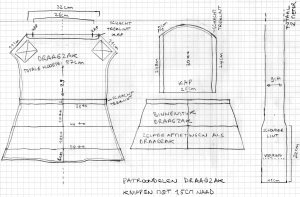
Je hebt de volgende stukken nodig:
(NB: als je alles uit één kleur maakt knip je gewoon alles behalve de treklinten dubbel)
– (1) draagzak: 1 van elke kleur (knip 1,5 cm naad extra)
– (2) kap: 1 van elke kleur (knip 1,5 cm naad extra)
– (3) binnenstuk draagzak: 1 van elke kleur (knip 1,5 cm naad extra)
– (4) schouderlinten: in totaal 2 x 2 meter van elke kleur, geknipt met de draadrichting mee. Knip 2 stroken van 13 cm breed (naad van 1,5 cm inclusief) en 1 strook van 12 cm als je 1,5 meter lange stof hebt.
– (5) heuplint: in totaal 3 meter van elke kleur, geknipt met de draadrichting mee. Knip stroken van 12 cm breed (naad van 1,5 cm inclusief)
– (6) treklinten: stroken van 5 cm breed: 1x 150 cm, 1x 100 cm en 2x 75 cm (in totaal 4 meter) uit één van de twee kleuren (!).
– (7) lussen voor de schouderlinten: in totaal 65 cm van elke kleur, stroken van 10 cm breed
– (8) vulling: 80 x 9 cm voor het heuplint en 2 maal 60 x 11 cm voor de schouderlinten. Knip de schouderlinten smaller vanaf 11 cm lengte om overeen te komen met de versmalling van de stof (zie foto).
Hieronder een voorbeeld van hoe je dit kan uitknippen. Je kan natuurlijk ook de stof en de patroondelen dubbelvouwen.
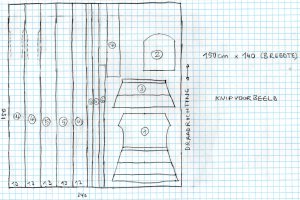
Bij het knippen van de patroondelen is het handig om de eerste uitgeknipte kleur op de tweede te leggen (zelfde stofkanten op elkaar), zo komen je naden later netjes overeen.
Wanneer je alle patroondelen hebt uitgeknipt, markeer je de naden en details met kleermakerskrijt.
Opmerking vooraf: de naden mag je altijd tesamen afwerken tegen het rafelen, tenzij er staat ‘strijk de naden open’. De zigzag functie van mijn naaimachine werkt niet goed dus de mijne zijn met rechte steken afgewerkt, maar een zigzag of interlock als je dat hebt is handiger tegen het rafelen.
We beginnen met de linten.
Heuplint: als je stof minder lang is dan 3 meter, stik dan eerst de korte kanten aan mekaar. Strijk de naden open en werk af. Doe dit voor beide kleuren. Leg dan de goede kanten van de stof op elkaar en stik de naden door tot 9 cm breedte. Stik één van de korte kanten schuin af voor het uiteinde van je lint, knip de overtollige stof weg en werk alle naden af tegen rafelen.
Schouderlinten: zet de stof met de korte kanten aan elkaar zodat je twee linten van minstens 2 meter hebt. Strijk de naden open en werk af. Doe dit voor beide kleuren. Leg dan de goede kanten van de stof op elkaar en stik de linten door tot 11 cm breedte op de eerste 22 cm, om dan te versmallen naar 9 cm breedte voor de rest van het lint. Het stuk van 11 cm breedte vormt de aansluiting aan de draagzak en wordt voor de eerste 11 cm weggewerkt in de zak, voor de stevigheid. Mijn schouderlinten waren 150 cm + 50 cm in de lengte en ik maakte het stuk van 11 cm breedte aan het begin van de langste strook van 150 cm, zodat de naad quasi altijd onzichtbaar is wanneer je de draagzak hebt geknoopt.
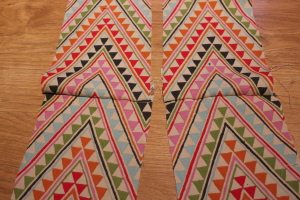
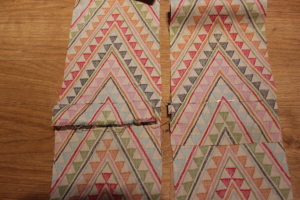
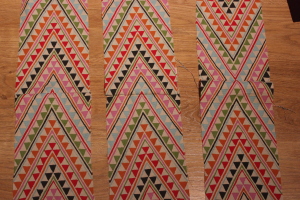
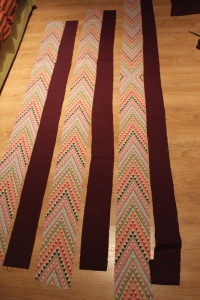
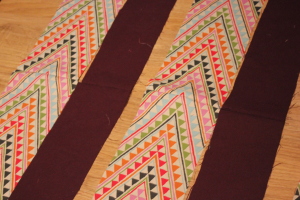

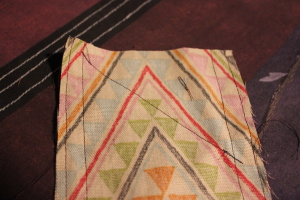
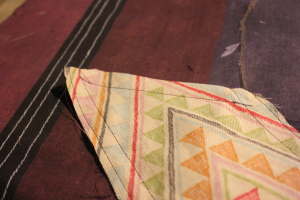
Leg de vulling op de linten en duid met kleermakerskrijt aan tot hoe ver die moet komen. Laat voor de schouderlinten 11 cm van de brede strook vrij van vulling, dit stuk komt in je draagzak. Voor het heuplint betekent dit dat je het midden van de vulling gelijk legt met het midden van je lint en langs beide kanten aftekent. Draai de linten binnenste buiten (de goede kant naar buiten) en strijk ze goed plat langs de naden. Nu volgt een prulwerkje: de vulling erin steken. Begin met de schouderlinten. Rol het lint terug binnenste buiten op totdat je aan de streep bent gekomen. Zet op dit punt de vulling vast aan de stof met naald en draad en enkele steken en een stevige knoop. Rol dan de stof terug over de vulling totdat de vulling er helemaal in zit. Frutsel ermee totdat de vulling netjes plat in het lint zit (je moet de vulling eigenlijk een beetje ‘masseren’). Knip de steekjes die je maakte weer door. Doe hetzelfde met het heuplint. ‘Masseer’ totdat de vulling mooi in het midden zit. Dit is nog een groter foefelwerkje omdat de vulling hier in het midden van het lint moet komen maar houd moed, je zal een heerlijk zachte draagzak hebben. Strijk daarna de linten netjes plat, ook over de vulling.
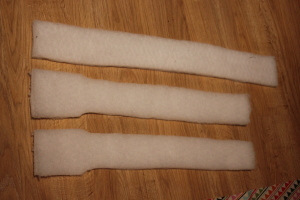
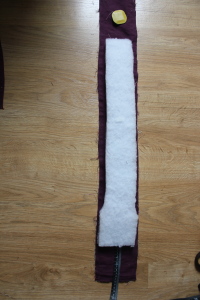
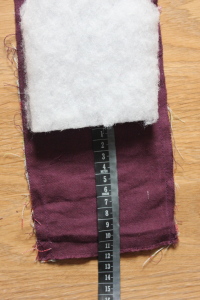
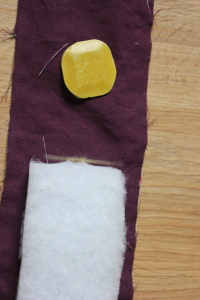
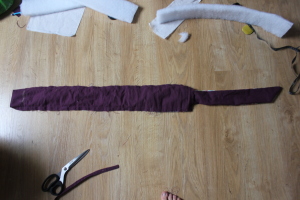
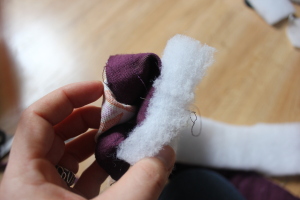
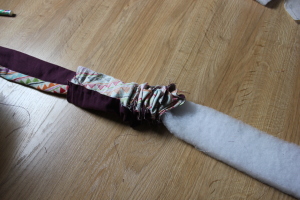
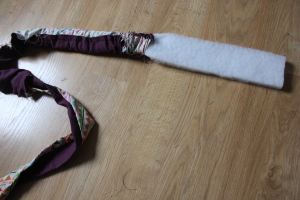
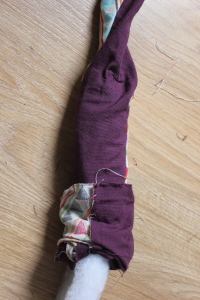
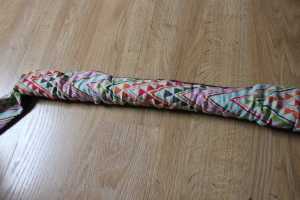
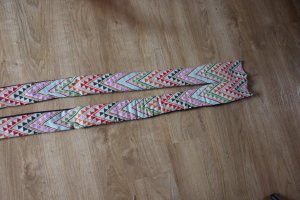
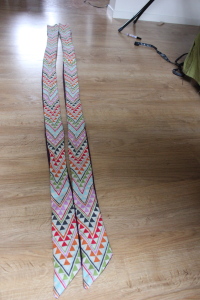
Maak de andere kant van het heuplint af door schuin af te knippen, enkele steekjes van de naad los te tornen, de naden naar binnen te draaien, strijken en zo vast te naaien. Stik de linten door op 3 en 6 cm breedte, bij de dikkere gedeeltes moet je de stof soms wat door de naaimachine ‘helpen’. Stik de uiteindes nog eens door. Je linten zijn klaar!

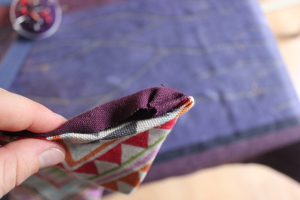
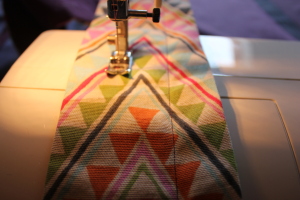
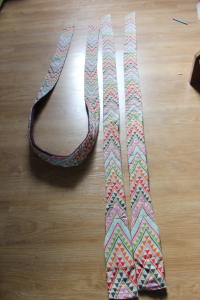
Treklinten: Deze maak je van de stroken van 5 cm breed. Begin met de linten dubbel te vouwen en dit goed te strijken. Plooi vervolgens de uiteindes naar binnen, zodat je een mooi lint van ongeveer 1,5 cm breed krijgt. Speld vast indien nodig, strijk opnieuw en stik aan weerskanten helemaal door. Stik heen en weer op het uiteinde om rafelen te voorkomen. Je treklinten zijn klaar!
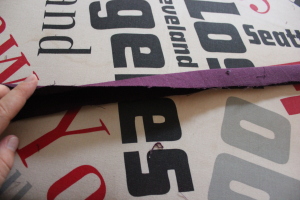
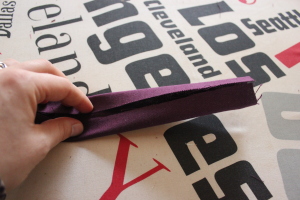
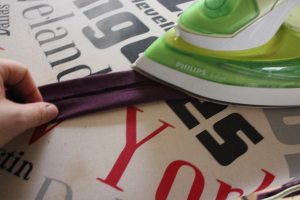



Lussen voor de schouderlinten: Maak deze lussen zoals de treklinten, van de stroken van 10 cm breed zodat je eindigt met linten van ongeveer 3 cm breed. Je gaat deze lussen bevestigen op 10, 20 en 30 cm hoogte van de schouderlinten, aan twee kanten tegelijk. Meet 10 cm vanaf het begin van de vulling in de schouderlinten (!! de eerste 11 cm komen straks in de draagzak te zitten ter versteviging). Speld het lussenlint op deze hoogte vast in het midden van het schouderlint, met de lange kant naar het begin van het schouderlint gericht. Speld het lussenlint van de andere kleur vast op dezelfde plaats en controleer of ze overeen komen. Naai dan het lint vast. Opgepast, bij dit stuk zijn mijn jeansnaalden gebroken. Ik laat de machine gewoon een lengte vooruit en dan weer achteruit naaien, niet te snel. Als dit vast zit, meet je 7 cm vanaf het stiksel en knip je de lussenlinten daar af. Plooi één van de twee lussen (best de kleur die je hebt gekozen voor je draad) om en vouw het uiteinde eronder, speld vast zodat je een lus krijgt, zorg dat het stuk aan de andere kant niet in de weg zit en naai vast. Draai nu het schouderlint om en zet de tweede kleur vast op hetzelfde stiklijntje. (Als je probeert om beide kanten tegelijk te doen komt het bijna nooit netjes uit, omdat je zo’n dik pak onder je naaivoet moet schuiven). Herhaal dit op 20 cm en op 30 cm van het uiteinde van het schouderlint, maar maak van de lus bij 30 cm een dubbele: in plaats van af te knippen op 7 cm naai je de lus eerst één keer vast, maak je een nieuwe lus van 7 cm en doe je dan de eindhandeling. Herhaal voor het tweede schouderlint.

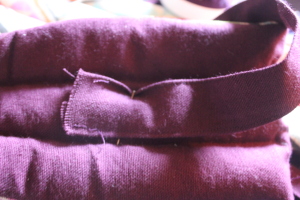


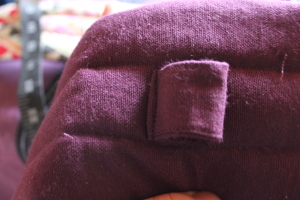
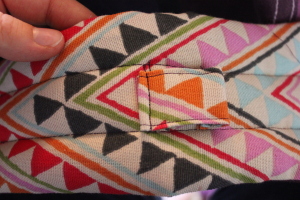
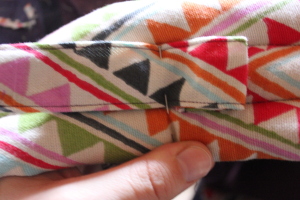
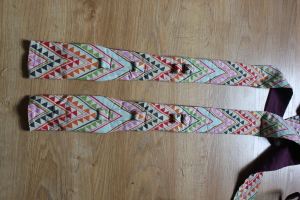
De kap van de draagzak: De kap heeft aan weerskanten een schacht voor de treklinten, die je kan gebruiken om de kap als neksteun te laten dienen of om de kap omhoog te houden. De schachten zijn 2 cm breed en de stof moet bovenaan omgenaaid worden over die breedte. Begin met een knip aan weerskanten in de naad (zie foto). Sla de stof om, knip af tot 1 cm en zigzag tegen het rafelen. Stik ze netjes vast op 0,5 cm. Als je dit voor de beide panelen van de kap hebt gedaan leg je de goede kanten op elkaar en stik je op de naden, behalve de onderkant en de openingen van de schachten die je net hebt gemaakt. Knip het ronde deel enkele keren in. Keer de kap binnenstebuiten en strijk plat. Naai de schachten van het treklint op 2 cm breedte van de rand en werk af met het doorstikken van de afgeronde bovenkant van de kap op 0,5 cm. Trek er de twee treklinten van 75 cm door met behulp van een veiligheidsspeld. De kap is klaar!
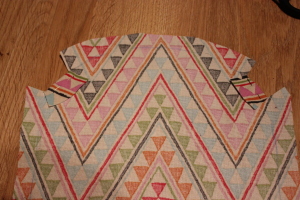
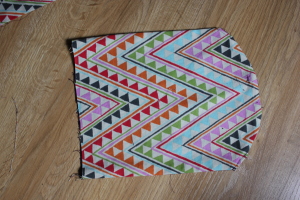
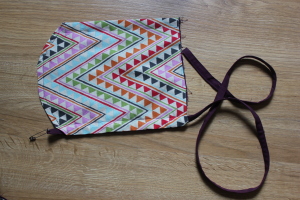
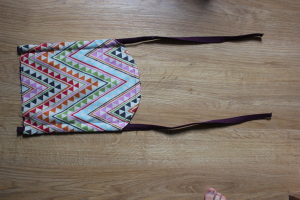
Draagzak: Start met het binnenstuk van de draagzak. Dit dient om extra versteviging te creëren voor het heuplint en treklint dat hier later door gaat. Werk de zoom van de horizontale kanten van het binnenstuk af tegen rafelen. Leg het binnenstuk op het draagzak paneel met de goede kanten op elkaar en stik de zijnaden tot aan de hoeken van het patroon (dus niet helemaal doorstikken naar onder en boven). Knip in waar je naad stopt. Werk de naden af tegen rafelen. Draai binnenstebuiten en strijk de zijnaden plat. Stik door op 0,5 cm afstand van de rand. Doe dit voor beide delen.
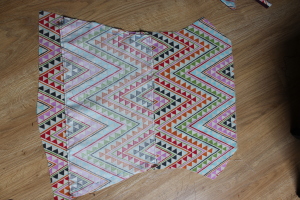
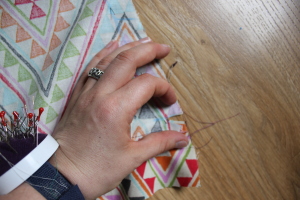
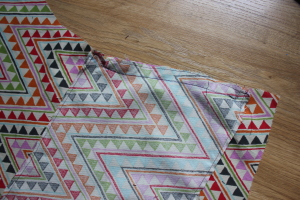
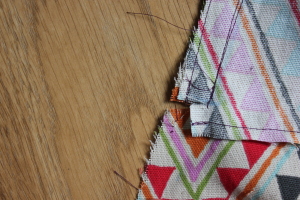
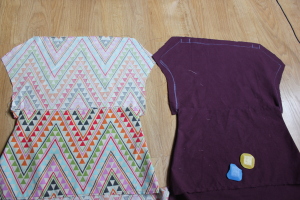
Maak ook de uiteindes van de schacht voor het treklint onder de kap. Knip de naden in ter hoogte van het stukje tussen de kap en de schouderlinten (zelfde als bij de kap). Knip de naden tot op 1 cm, werk de uiteindes af tegen rafelen, plooi om en stik door op 0,5 cm van de rand. Knip de overtollige stof weg.
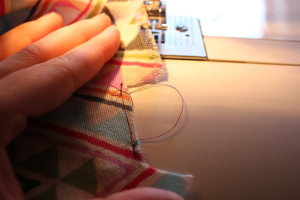
Nu komt de grote finale: de assemblage van alle onderdelen!
Leg één van de twee draagzak panelen met de goede kant naar boven. Leg de kap hierop, bovenaan in het midden met de zelfde kleuren tegen mekaar (tenzij je wilt dat de kap een andere kleur heeft dan de zak). Zorg dat de lintjes van de kap nergens op een toekomstige naad liggen. Leg de schouderlinten ook op het draagzak paneel, met de naad ter hoogte van het begin van de vulling, zodat er ongeveer 11 cm uitsteekt. Zorg dat de uiteindes naar buiten komen ter hoogte van het binnenstuk dat je eerder naaide. Leg de tweede kleur draagzak hierop met de goede kant naar binnen en zorg dat alles mooi op mekaar past. Speld alles netjes tesamen: de naad van de kap, de naden van de schouderlinten (opgelet, het stukje hier tussen niet stikken, hier komt nog een schacht voor een treklint!), de zijnaden tot aan het binnenstuk, de korte zijnaad onder het binnenstuk en de onderste naad. Opmerking: ik bedacht achteraf dat het misschien handig zou zijn om een lusje te hebben om de zak mee op te hangen zoals een jas. Als je nog een restje treklint hebt kan je dat hier in het midden van de kap steken. Stik alle naden door en werk af tegen rafelen. Knip naden van de rondingen aan de zijkant onder de schouderlinten enkele keren in. Draai dan binnenste buiten langs de openingen in het binnenstuk. Stik de naden door op 0,5 cm van de rand langs de zijkant en onderkanten (behalve het binnenstuk). Stik dan de laatste stukken: 2 cm onder de kap voor de schacht van het treklint, een vierkant met kruis (mijn vierkant is 8 x 8 cm) ter versteviging van de schouderlinten en de drie schachten voor het heuplint en het treklint. Die laatste doe je op 2 – 10 – 10 cm afstand, ter hoogte van het binnenstuk. Stop je heuplint erdoor et voilà, je draagzak is klaar!

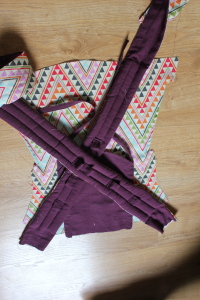
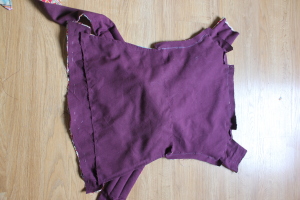
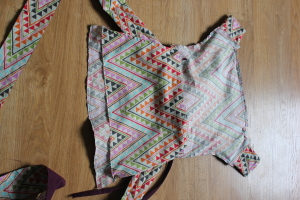

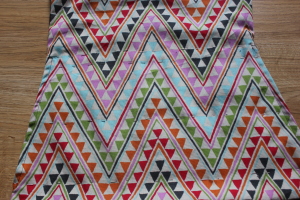
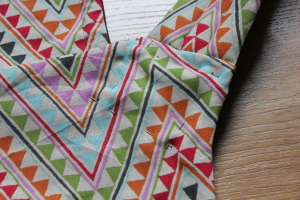
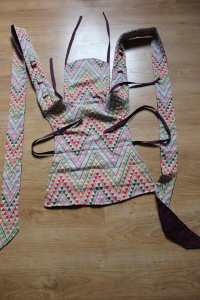
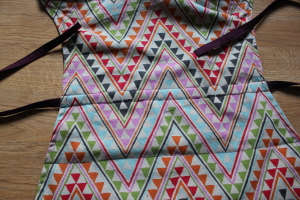
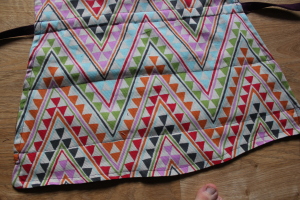
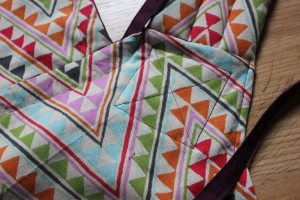
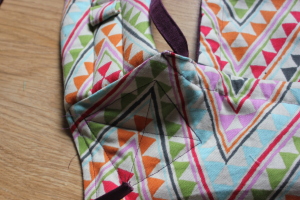
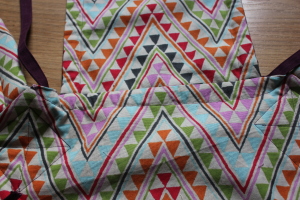
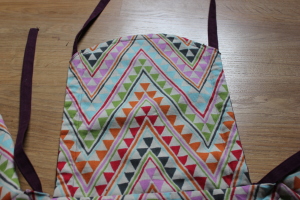
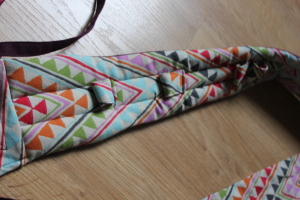
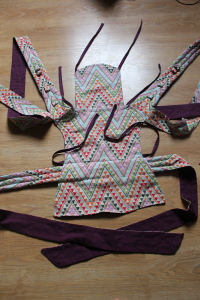
Draagtips:
Hoe ga je nu aan de slag met je draagzak? Hier enkele algemene en specifieke tips:
– voor kleine baby’s stop je het heuplint in de bovenste schacht, als je oogappel wat groter wordt kan je de zak ook groter maken met de onderste schacht. Het horizontale treklint halverwege kan je gebruiken om de zak smaller te maken. Het is belangrijk dat je baby altijd een breed zitvlak heeft met de beentjes in ‘kikkerhouding’ en de knietjes boven de poep.
– Zorg dat je baby ongeveer op ‘kushoogte’ hangt: je moet met je mond aan zijn hoofdje kunnen. Dat is belangrijk voor jouw ergonomie. Het dragen mag niet oncomfortabel aanvoelen! Experimenteer eventueel met de juiste hoogte.
– Zorg dat de linten zo min mogelijk verfrommeld zijn en je ze zo breed mogelijk gebruikt. Je baby mag ook goed strak aangetrokken worden zodat hij goed in de zak zit en je het gewicht dicht bij jou draagt.
Hoe de baby in de draagzak steken (oefen eerst met een knuffel als je je onzeker voelt):
– Bind het heuplint rond en maak vast met een dubbele knoop. Trek het treklint aan om de zak eventueel smaller te maken en maak vast met een lusknoop aan beide kanten.
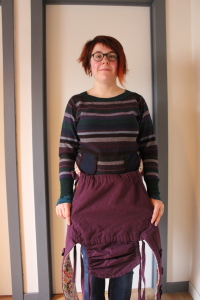
– Neem je baby op en zet hem met beide beentjes aan weerskanten van de zak, tegen je buik. Houd de baby ten allen tijde vast met één hand!

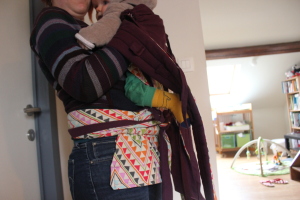
– Trek één schouderlint over je schouder en trek het kruiselings over je rug en onder het beentje van de baby. Wissel van hand en doe hetzelfde met het andere schouderlint. Trek goed aan. Nu kan je de linten een eerste keer goed vastknopen onder het zitvlak van je baby. Ofwel knoop je ze hier vast, ofwel kan je nog eens naar je rug doen en daar vastzetten met een dubbele knoop.
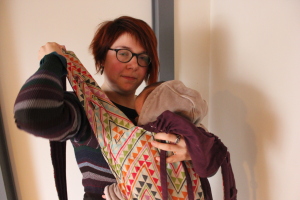
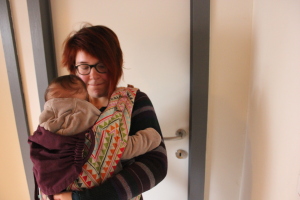
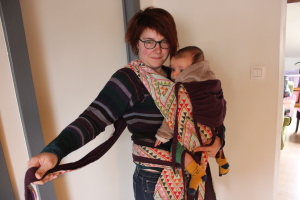
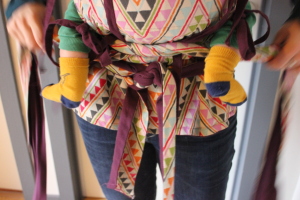
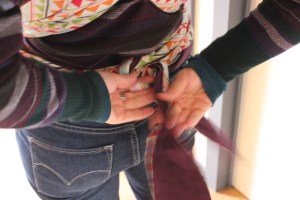
– Je kan de kap smaller maken met het horizontale treklint. Je kan ook een neksteun maken door de kap wat op te trekken over de twee treklinten en die vast te zetten aan de lussen op de schouderlinten. Voilà, je bent klaar om naar buiten te gaan!

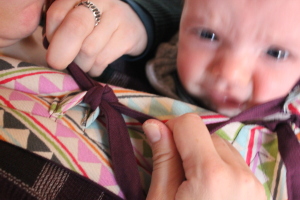



Voor meer tips, rugdragen enz… verwijs ik graag naar een goede workshop door een gecertificeerde draagconsulent, in Brussel is dat bijvoorbeeld Myriam Drabs: hier en hier kan je checken wanneer er een sessie plaatsvindt. In Leuven heeft Doekjes en Broekjes ook workshops.
Veel plezier ermee!

